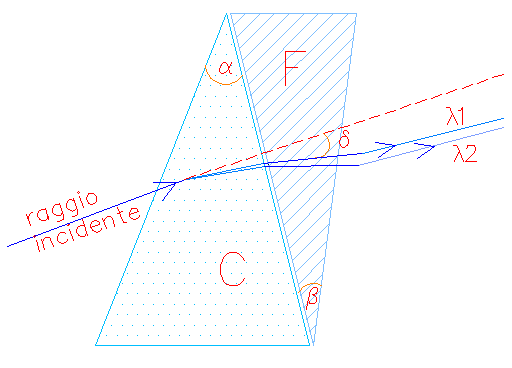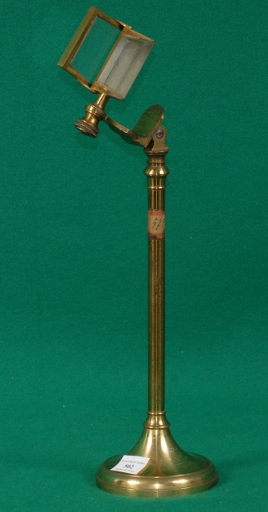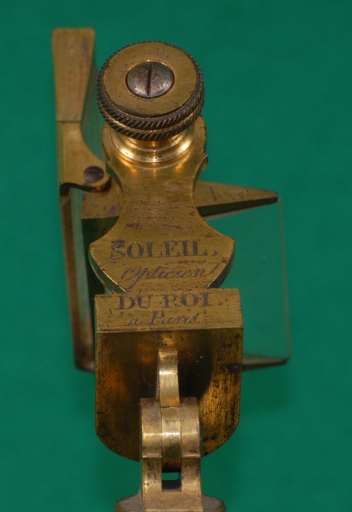» Isosceles Prism (0502)
Immagini



DESCRIPTION
Exhibit 502 consists of two isosceles prisms arranged as in design-2. The two prisms, inverted one respect to the other, are mounted in a brass frame rotatable about two orthogonal axes and supported on a brass rod having a circular base (photo-1).
A light ray passing through a prism is deviated by an angle that depends on the color of the light, since the index of refraction depends on the wavelength (λ) of the incident light. The dispersion of a prism (or dispersive power) is the difference between the deviation minimum that the prism produces for red lines (λ=656,3 nm) and blu (λ=486,1 nm) of hydrogen.
Different materials have different dispersive powers. The dispersive power of flint glass is greater than that of crown glass: Combining properly two prisms of the two glasses, it is possible a deviation which is independent of the color of the light ray. In this case, the system of the two prisms constitutes an achromatic prism.
In an isosceles prism with vertex angle α one can show that, in condition of minimum deviation δ, the refractive index μ can be found from the following relation:
![Equazione: [\mu=\frac{\sin(\frac{\alpha+\delta}{2})}{\sin\frac{\alpha}{2}}\eqno{(1)}] Equazione: [\mu=\frac{\sin(\frac{\alpha+\delta}{2})}{\sin\frac{\alpha}{2}}\eqno{(1)}]](/foto/equaz/502_eq01.png)
For the prisms we are examining (see design-2) the refracting angle (α) is very small, and therefore also the angle of minimum deviation δ. The relation (1) thus reduces to:
![Equazione: [\mu = \frac{\alpha+\delta}{\alpha}] Equazione: [\mu = \frac{\alpha+\delta}{\alpha}]](/foto/equaz/502_eq02.png)
![Equazione: [\delta = (\mu-1)\cdot \alpha] Equazione: [\delta = (\mu-1)\cdot \alpha]](/foto/equaz/502_eq03.png)
We calculate the dispersive power of the Crown and Flint glasses, remembering that the dispersive power of a material is defined as:
![Formula: [\omega = \frac{(\mu_v-\mu_r)}{\mu -1}] Formula: [\omega = \frac{(\mu_v-\mu_r)}{\mu -1}]](/foto/equaz/502_fr01.png) ,
where μ is the average index of refraction (by convention it is the index of refraction for yellow light)
,
where μ is the average index of refraction (by convention it is the index of refraction for yellow light)
For the Crown prism, with deviation ![Formula: [\delta_v\, ,\delta_r] Formula: [\delta_v\, ,\delta_r]](/foto/equaz/502_fr02.png) ,
the index of refraction
,
the index of refraction
![Formula: [\mu_v\, ,\mu_r] Formula: [\mu_v\, ,\mu_r]](/foto/equaz/502_fr03.png) , and angle of refraction of the prism α
one has:
, and angle of refraction of the prism α
one has:
![Equazione: [\delta_v-\delta_r =(\mu_v-\mu_r)\cdot \alpha] Equazione: [\delta_v-\delta_r =(\mu_v-\mu_r)\cdot \alpha]](/foto/equaz/502_eq04.png)
For the Flint prism, with deviation ![Formula: [\delta'_v\, ,\delta'_r] Formula: [\delta'_v\, ,\delta'_r]](/foto/equaz/502_fr04.png) index of refraction
index of refraction
![Formula: [\mu'_v\, ,\mu'_r] Formula: [\mu'_v\, ,\mu'_r]](/foto/equaz/502_fr05.png) , and angle of refraction of the prism β
one has:
, and angle of refraction of the prism β
one has:
![Equazione: [\delta<sub>v</sub>^{'}-\delta<sub>r</sub>^{'} =(\mu<sub>v</sub>^{'}-\mu_r^{'})\cdot\beta] Equazione: [\delta<sub>v</sub>^{'}-\delta<sub>r</sub>^{'} =(\mu<sub>v</sub>^{'}-\mu_r^{'})\cdot\beta]](/foto/equaz/502_eq05.png)
For achromatic (dispersion zero), the condition is:
![Equazione: [\delta_v-\delta_r = \delta_v^{'}-\delta_r^{'}] Equazione: [\delta_v-\delta_r = \delta_v^{'}-\delta_r^{'}]](/foto/equaz/502_eq06.png)
![Equazione: [(\mu_v - \mu_r)\cdot\alpha =(\mu_v^{'}-\mu_r^{'})\cdot\beta] Equazione: [(\mu_v - \mu_r)\cdot\alpha =(\mu_v^{'}-\mu_r^{'})\cdot\beta]](/foto/equaz/502_eq07.png)
Multiplying numerator and denominator by (μ-1) at the first member and by (μ'-1) at the second member one obtains:
![Equazione: [\frac{(\mu_v-\mu_r)\cdot\alpha\cdot(\mu -1)}{\mu -1} = \frac{(\mu_v^{'}-\mu_r^{'})\cdot\beta\cdot(\mu^{'} -1)}{\mu^{'} -1}] Equazione: [\frac{(\mu_v-\mu_r)\cdot\alpha\cdot(\mu -1)}{\mu -1} = \frac{(\mu_v^{'}-\mu_r^{'})\cdot\beta\cdot(\mu^{'} -1)}{\mu^{'} -1}]](/foto/equaz/502_eq08.png)
One deduces therefore:
![Equazione: [\omega\cdot\delta=\omega^{'}\cdot\delta^{'}] Equazione: [\omega\cdot\delta=\omega^{'}\cdot\delta^{'}]](/foto/equaz/502_eq09.png)
That is
![Equazione: [\frac{\omega}{\omega^{'}} = \frac{\delta^{'}}{\delta}\eqno{(2)}] Equazione: [\frac{\omega}{\omega^{'}} = \frac{\delta^{'}}{\delta}\eqno{(2)}]](/foto/equaz/502_eq10.png)
From the relation (2) one sees that the combination of the two prisms will be achromatic (that is without dispersion) if their dispersions are inversely proportional to the deviation produced.
In the combination of the prisms Flint and Crown, the values of the refraction angles (β) of the index of refraction(![Formula: [\mu^{'}] Formula: [\mu^{'}]](/foto/equaz/502_fr07.png) )
for the Flint prism are less than
(α) e (μ) for the Crown prism, because the dispersive power of the Flint prism (
)
for the Flint prism are less than
(α) e (μ) for the Crown prism, because the dispersive power of the Flint prism (![Formula: [\omega^{'}] Formula: [\omega^{'}]](/foto/equaz/502_fr08.png) ) is greater than that of the Crown prism
(ω).
) is greater than that of the Crown prism
(ω).
For an optimum combination we have
This property has great practical value for eliminating chromatic aberration in lenses.
ISCRIZIONI
- Reca inciso "SOLEIL opticien DU ROI à Paris"
BIBLIOGRAPHY
- [1] Perucca E.,"Fisica Generale e Sperimentale", Vol II, 1937, Pag. 51
- [2] URL [ http://www.museodifisica.it/ITA/htm/strumento.php?id=80 ]
Dati Catalografici
| Data di costruzione: | --- |
|---|---|
| Data di carico: | Ignota |
| Nr. Inventario: | Ignoto (Ignoto) |
| Costruttore: | SOLEIL |
| Materiale: | vetro, ottone |
| Dimensioni: | Altezza supporto: 32 cm, diametro: 9 cm; Prismi con rete metallica: 3,5 cm x 5 cm x 1,4 cm |
| Conservazione: | ottimo |
